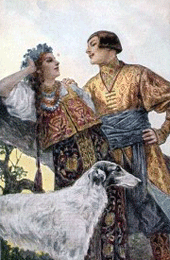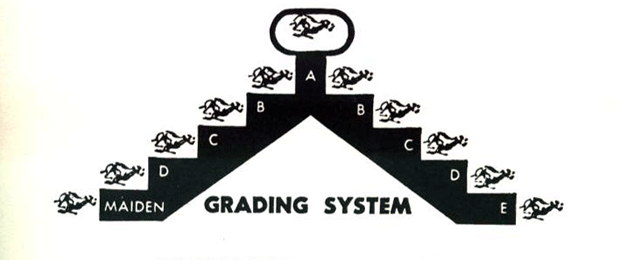|
|
Progress Publishing Co. |
|
|
Greyhound Grading System |
|
|
Progress Publishing Co. |
|
|
Greyhound Grading System |

![]()

![]()
Greyhound Grading System
*******************************************************************
Greyhound grading system
Greyhound grades
Greyhound grading rules
*******************************************************************
Greyhound grading system
When a greyhound racing secretary plans greyhound races, the most important problem for him to solve is to guarantee a fair contest for the dogs and the most interesting race for the public. This is done with the help of the greyhound grading system. The grading system that is generally accepted is Hartwell Grading System. It was developed and implemented on greyhound race tracks in 1950. Every greyhound is assigned a proper grade (“class) according to the grading system. Only greyhounds belonging to the same grade can compete in the same greyhound race. That basic approach gives every greyhound a fair chance at winning. The general principle behind grading system is: if a greyhound keeps winning, it moves to a higher grade. If a greyhound is on the losing streaks, its grade goes down. The specific race a greyhound will compete in is determined on a random basis. The same way a greyhound post position before the race is chosen randomly.
Greyhound grades
Greyhound grading system includes different grades representing the levels of performance of the greyhound. The number of grades may vary from one race track to another. Most of the greyhound race tracks use six grades. Every greyhound grade is indicated by a letter. The letters for six grades are: A, B, C, D, E and M. The letter A is for the highest grade and the letter M stands for maiden dogs. A maiden dog is a greyhound that has never won. Few tracks use a different combination of letters.
Greyhound grading rules according to Hartwell Grading System
1) There are six greyhound grades indicated by the alphabet letters: A, B, C, D, E and M.
2) The greyhound that has won the race advances to the next grade.
3) The highest grade that greyhound can reach is the Grade A.
4) If a greyhound with A, B or C grading fails to finish in the money (1st, 2nd or 3rd place) in three consecutive races, it will be downgraded to the previous grade.
5) If a greyhound with A, B or C grading fails to take a 3rd place at least twice in four consecutive races, its grading will be lowered one step down.
6) If a greyhound with “D” grading fails to finish 1st, 2nd, 3rd or 4th in four consecutive starts, its grading will go down.
7) If a greyhound with “E” grading could not finish 1st, 2nd, 3rd or 4th in four consecutive races it will be removed from further racing.
8) If a maiden greyhound finished 2nd, 3rd or 4th in a maiden race, the greyhound owner or trainer may request a racing secretary to move that greyhound to the next grade. If request is granted, the greyhound will compete in future races according to the rules of the grading system. The name of that greyhound on the racing program for its next race will be accompanied by letter M (maiden).
9) All races planned by the racing secretary will be marked by the letter “T” on the racing program. All stake races will be designated by the letter “S”.

Illustration of how Hartwell Grading System works.
Copyright Progress Publishing Co. 2006
Selected References:
| John Scarne New Complete Guide to Gambling | The Gambling Times Guide to Winning Systems |
| Kelso Sturgeon Guide to Sports Betting | Alice Fleming Something for Nothing/A History of Gambling |
| Carl Sifakis The Encyclopedia of Gambling | Alan Wykes The Complete Illustrated Guide to Gambling |
| Prof. Jones Winner's Guide to Greyhound Racing | William E. McBride Greyhound Racing |